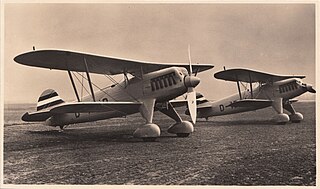Related Research Articles
This is a list of aviation-related events from 1937:

A medium bomber is a military bomber aircraft designed to operate with medium-sized bombloads over medium range distances; the name serves to distinguish this type from larger heavy bombers and smaller light bombers. Mediums generally carried about two tons of bombs, compared to light bombers that carried one ton, and heavies that carried four or more.

The Heinkel He 51 was a German single-seat biplane fighter aircraft. A seaplane variant and a ground-attack version were also developed. It was a development of the earlier He 49.
The Italian Co-Belligerent Air Force, or Air Force of the South, was the air force of the Royalist "Badoglio government" in Southern Italy during the last years of World War II. The ACI was formed in Southern Italy in October 1943 after the Italian Armistice in September. As by this point the Italian Kingdom had defected from the Axis and had declared war on Germany, the ACI pilots flew for the Allies.

The Savoia-Marchetti SM.79 Sparviero was a three-engined Italian medium bomber developed and manufactured by aviation company Savoia-Marchetti. It may be the best-known Italian aeroplane of the Second World War. The SM.79 was easily recognizable due to its fuselage's distinctive dorsal "hump", and was reportedly well liked by its crews, who nicknamed it il gobbo maledetto.
This is a list of aviation-related events from 1938:
SIAI-Marchetti was an Italian aircraft manufacturer primarily active during the interwar period.

Ala Littoria S.A. was the Italian national airline that operated during the fascist regime in the 1930s and 1940s.

The National Republican Air Force was the air force of the Italian Social Republic, a World War II German puppet state in Italy.

The Legionary Air Force was an expeditionary corps from the Italian Royal Air Force that was set up in 1936. It was sent to provide logistical and tactical support to the Nationalist faction after the Spanish coup of July 1936, which marked the onset of the Spanish Civil War.

Alfa Romeo built/designed a range of aircraft engines based on the Bristol Jupiter and Bristol Pegasus designs, designated Alfa 125, Alfa 126, Alfa 127, Alfa 128, Alfa 129 and Alfa 131. All these essentially similar engines were mainly fitted to Italian bombers in World War II, Alfa Romeo building around 11,000 units between 1934 and 1944
The Romanian Naval Aviation was the air arm of the Royal Romanian Navy. It was founded in 1920 as Escadrila de hydroplane and operated Hansa-Brandenburg W.29 floatplanes and Hansa-Brandenburg FB flying boats. These were followed by native-built aircraft and imports from Italy and Germany (floatplanes), resulting, by the time of the Second World War, in a sizable and active force of over 70 watercraft. Currently the Romanian Naval Aviation consists of Grupul 256 Elicoptere equipped with IAR 330 Naval helicopters.
References
- ↑ vvswarbirds (2018-05-05). "Polikarpov's I-15 and I-15bis biplane fighters". vvs air war. Retrieved 2021-04-28.
- ↑ "I-16 Type 10 over Spain DUAL COMBO 1/48". Eduard. Retrieved 2021-04-28.
- ↑ "Heinkel 112 B Luftwaffe 92138". Belles Arts Ferran, S.L. (in French). Retrieved 2021-04-28.
- ↑ Drawn, War Machines (2016-03-27). "War Machines Drawn: Arado Ar.68E - Spanish users". War Machines Drawn. Retrieved 2021-04-28.
- ↑ "Hispano HA-112 MIL Buchon (G-AWHK)". Flying Legends. 2014-06-10. Retrieved 2021-04-28.
- ↑ P, Marko (2019-04-25). "Fiat G.50 Freccia". Plane-Encyclopedia. Retrieved 2021-04-28.
- ↑ Deano (2019-01-26). "The Survivors: Spain's Fiat CR.32 Cricket & Her Old Foes". Aces Flying High. Retrieved 2021-04-28.
- ↑ "Luftwaffe Resource Center - Bombers - A Warbirds Resource Group Site". www.warbirdsresourcegroup.org. Retrieved 2021-04-29.
- ↑ Hansen, Robert (2019-07-11). "Breda Ba.65 Fighter-Bomber Aircraft". Comando Supremo. Retrieved 2021-04-29.
- ↑ "Heinkel He 111 Operations, Hobbymaster Arrivals, Civilian Model Sale !". Flying Tigers. 2019-03-21. Retrieved 2021-04-29.
- ↑ Goss. 2005. p. 97.
- ↑ "Trumpeter 1/48 Savoia-Marchetti S.M.79-II Sparviero # 02817". Model Hobbies. Retrieved 2021-05-03.
- ↑ "B-25 History Project". b-25history.org. Retrieved 2021-05-04.
- ↑ SeaplaneInternational (2017-02-06). "Dornier 24 seaplane at Madrid, Han de Ridder's photos". Seaplane International. Retrieved 2021-05-04.
- ↑ Book description included Spanish use of FW 200. ASIN 1903223962.
- 1 2 "Other Forces - Spanish Cant-Z-506s". www.ww2incolor.com. Retrieved 2021-05-04.
- ↑ "The Spanish Bücker CASA 1.131 D-EIWW". www.flying-wings.com. Retrieved 2021-05-04.